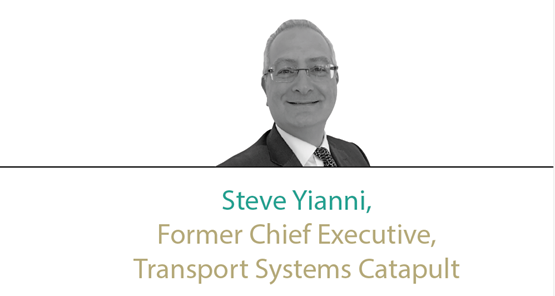
The case for rail investment is irresistible… or at least it should be. When aligned with other infrastructure it builds communities, fuels economic growth and creates jobs, in turn generating revenue that can be pumped right back into
further investments in technology, infrastructure and skills that support sustainable growth. Of course, it’s not as straightforward as that - integrated infrastructure investment is hamstrung by a fragmented planning process and sometimes serious misalignment between local and national interests.
With Network Rail’s reclassification effectively preventing it from further borrowing, the need to attract private investment is stronger than ever. While its move to open up a pipeline of project opportunities to third parties will find new revenue streams, there are barriers that must be removed first, the most significant of which is risk and uncertainty.
Rail needs to offer potential investors returns that carry an acceptable level of risk and a good degree of certainty. This sounds obvious, but an endemic lack of co-ordination between developers, local authorities and infrastructure providers has led to inadequate transport solutions that fail to address the needs of users and fall short of their development potential. Reading station’s success was driven by a strong local voice that was heard by regional bodies and encouraged national bodies to engage and understand the business case - creating a forum for the local and regional voice in planning and development is critical.
To create conditions that will enable infrastructure investment to thrive we must first look at challenging our planning system to be one that reduces risk.
Let’s take a new transport hub as an example. Complete with multi-modal interchange for passengers and goods, this hub brings with it an attractive opportunity to create a mega-development around it, one that comprises homes, retail and leisure facilities - regeneration, jobs and economic growth.
However, the existing consenting mechanisms for securing the powers needed to achieve this (Transport and Works Act orders, Development Consent Orders) are slow and rather blunt instruments focused on infrastructure rather than the related development opportunity which traditionally follows later in the programme. This limits certainty for investors that planning conditions will be favourable enough for them to invest with confidence, and defers an uncertain contribution to the cost of the infrastructure to a later point for the promoter. We need to find a new mechanism that balances protective powers against the need for economic progress, and it must be agile!
For private investment in rail to thrive, we also need to change the culture within our rail industry to one that instils confidence among investors that their risks are manageable. This is not going to happen overnight, but it can be achieved if the industry works together and focuses its efforts on addressing three key factors:
Protect the assets: infrastructure owners need to know that their assets will remain safe and be protected from potential developments, such as adjacent/oversight developments or new technology. But asset protection and assurance is a function often fraught with uncertainty and inconsistency for a private developer or investor, so a transparent approach that facilitates (rather than frustrates) is a must.
Avoid misunderstanding: Investment sometimes fails because the original estimate on potential returns was exaggerated. Infrastructure owners and those wishing to develop over and around fixed links must reach a realistic and joint appraisal of value. Both public and private sector players need to understand the business models belonging to their counterparts. We must also be realistic about where land values make oversight development viable, and equally where the railway is something to enable growth around a station. New ways must be found to link the opportunity created by the railway with the value created around it.
Work towards a common goal: For many private sector developments, particularly those attached to major transport hubs that feature multiple transport organisations and stakeholders, there can be many parties all pulling in different directions. Failure to act in concert is to the detriment of everyone’s investment when what is needed is an integrated solution. Failure to collaborate means wasted time and energy, and a wasted opportunity to show private investors that rail is worth another look.

Milton Keynes is celebrating 50 years since its formation via the Milton Keynes Development Corporation (MKDC) in 1967. It is a good example of a planned infrastructure system, incorporating all elements required for a well-functioning city, servicing the needs of its society.
MK was planned as a London overspill, with excellent transport connections via road and rail, and fast trains to London transporting people the 50 miles from MK Central (opened in 1982) to London Euston in just 30 minutes. The transport connections have been critical to the successful growth of the MK conurbation - rail passenger usage journeys now exceed eight million at MK stations, from its urban borough of 250,000 people, which represents a five-fold increase in population since the 1960s.
Transport planning has been (and continues to be) a key consideration for the unitary authority of Milton Keynes Council. However, the real success comes from the total system thinking, providing needs for the population and business alike. Housing and energy provision, together with the effective use of land, has enabled the city to continue to grow - even now, 50 years on, land is available for further business and residential expansion.
So successful has been the business growth that the authorities - MKDC, and now MK Council and the Parks Trust - have been major beneficiaries of the increased land values. MK is now a standalone economic power house, which has been noted by the National Infrastructure Commission (NIC), which sees the development of the Cambridge-MK-Oxford corridor as one of the key national UK priorities to develop further. The NIC is considering transport arteries and connections of road and rail, housing, water and energy provision for this economic belt based on high value-added manufacturing and services.
Despite the success of Milton Keynes, joined-up infrastructure systems thinking is lacking in the UK, and MK is a relatively rare example of what can be achieved. The current UK infrastructure investment programme is huge, and with the Department for Transport being the largest capital spending department across central government, transport infrastructure investment is in need of more systems thinking to better serve the needs of society. The NIC only has recommendation powers, so Government departments do not need to follow its advice. Examples of inconsistencies across Government departments and central government policy are surprisingly frequent, which highlights the need for a body such as the NIC to have more powers to force integrated systems thinking. Regulators also need to work together more closely to gain best effect for the benefits of consumers and society.
As an example, to meet the needs of the Paris Climate Change commitments, decarbonisation is a policy need. As such, electrification of transport is an appropriate approach, provided the UK has a sensible mix of non-fossil fuel power generation.
The UK Government announcement in July 2017 to abolish diesel and petrol cars by 2040 is seen as a welcome intervention. This was backed up by significant funding for the research and development of battery technologies as part of the Industrial Strategy Challenge Fund, which is also consistent with this direction.
However, in the same month, the Government also announced the cancellation of major parts of the rail electrification programme, affecting the Midland and Great Western Main Lines and northern routes, while also announcing new hybrid diesel electric bi-mode rolling stock, which will have a lifespan significantly beyond the 2040 timeline for the abolition of petrol and diesel cars.
This was blamed on cost overruns for electrification, so why is the regulator not investigating why the costs have overrun so much? To take a whole systems view would review the design, safety, procurement, delivery, maintenance and operating costs for a whole-life cost assessment. This seems not to have been done sufficiently to challenge the cost overruns of the initial installation of the overhead wire systems.
This example highlights another Government inconsistency in its promotion of a rebalanced economy in a post-Brexit world, where the UK needs to become less dependent on London and the South East and promotes investment in other regions of the UK. However, also in July 2017, the Government announced support for Crossrail 2 in London, while in other regions electrification of the Midland Main Line north of Kettering, and west of Cardiff will not happen. Even Brunel’s Bristol Temple Meads station will now not be electrified as part of the cuts announced, with the route to Cardiff being serviced by electrification via Bristol Parkway. These mixed messages from central Government confuse the public and weaken investor confidence in the UK.
It is time for the UK to be bold and further expand electrification of the railways, an issue on which the UK lags significantly behind its European counterparts. The opportunity exists to apply systems thinking across the transport modes, with efficiencies and consumer benefits in deploying large-scale electrification of road and rail services.











